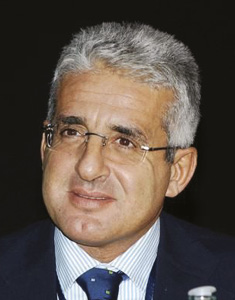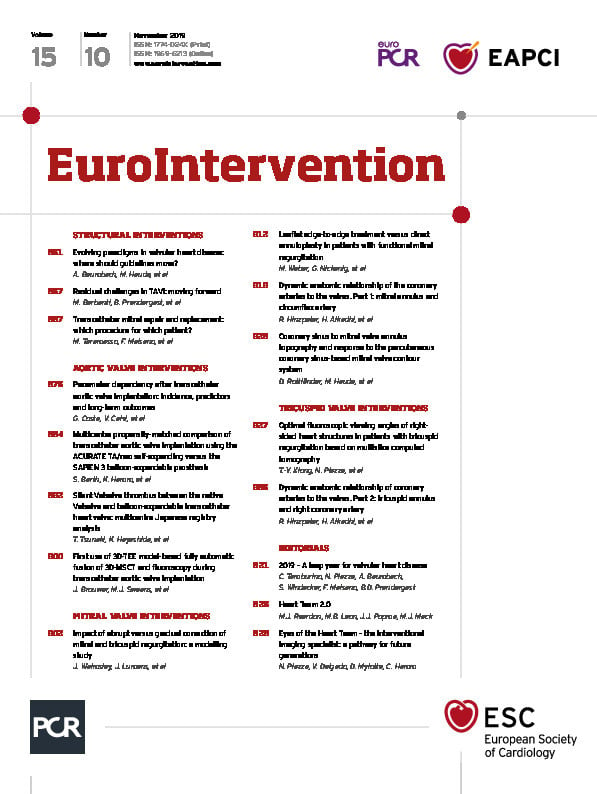
The last decade has seen tremendous growth in transcatheter therapies for valvular heart disease (VHD), with 2019 being a special year embracing ground-breaking achievements. In particular, clinical evidence has now reached a level sufficient to support expanded indications for different transcatheter valve interventions, prompting the need to refine optimal patient management and device use further.
In the field of transcatheter aortic valve implantation (TAVI), two recent randomised clinical trials comparing TAVI with surgical aortic valve replacement (SAVR) extend the large body of evidence concerning these two procedures to patients at low surgical risk. In the PARTNER 3 trial1, transfemoral TAVI using the balloon-expandable SAPIEN 3 prosthesis (Edwards Lifesciences, Irvine, CA, USA) was associated with a lower risk of the one-year primary composite endpoint of death, stroke or rehospitalisation compared with SAVR (8.5% vs 15.1%; p<0.001 for non-inferiority; hazard ratio [HR] 0.54, 95% confidence interval [CI]: 0.37-0.79; p=0.001 for superiority) among 1,000 patients at low surgical risk (mean age 74±6 years, Society of Thoracic Surgeons [STS] score 1.9±0.7%). In the EVOLUT Low Risk trial2, TAVI using the self-expanding supra-annular CoreValve®/Evolut™ bioprosthesis (Medtronic, Minneapolis, MN, USA) was non-inferior with respect to the two-year primary composite endpoint of death or disabling stroke compared with SAVR (5.3% vs 6.7%; posterior probability of non-inferiority >0.999) among patients (n=1,043) at low surgical risk (mean age 74±6 years, STS score 1.9±0.7%). Both devices have now been approved for use in low-risk patients by the US FDA. Furthermore, in an updated meta-analysis of seven randomised trials comparing TAVI versus SAVR in patients with severe, symptomatic aortic stenosis (n=8,020), TAVI was associated with 12% and 19% relative risk reductions of two-year all-cause death and stroke, respectively, regardless of underlying surgical risk3. These favourable outcomes of TAVI (which were consistent across the entire spectrum of surgical risk) constitute a paradigm shift that will affect the landscape for treating patients with severe aortic stenosis and pose new challenges for patient selection by the Heart Team (weighing clinical and anatomical factors to select the best treatment option for individual patients). The anticipated expansion of transfemoral TAVI will require further refinements, including more rational allocation of resources, reduced complication rates, assessment of device durability, technological advances and optimal techniques for more complex anatomies4.
High-quality randomised evidence has also emerged in the mitral intervention field, with studies assessing the clinical impact of transcatheter mitral valve repair versus standard medical therapy in patients with secondary mitral regurgitation. In the COAPT study5, 614 patients with symptomatic heart failure (left ventricular ejection fraction [LVEF] 20-50%) and severe secondary mitral regurgitation (effective regurgitant orifice area [EROA] >30 mm2) were randomly assigned to edge-to-edge MitraClip® (Abbott Vascular, Santa Clara, CA, USA) repair plus optimised medical treatment or optimised medical treatment alone. MitraClip repair was effective in 98% of patients and was associated with a significant reduction in the annualised rate of the primary endpoint within two years (hospitalisation for heart failure 35.8% vs 67.9% per patient-year: HR 0.53, 95% CI: 0.40-0.70, p<0.001; number needed to treat [NNT] 3.1, 95% CI: 1.9-7.9). Moreover, two-year all-cause mortality was significantly lower in the device vs the medical therapy group (29.1% vs 46.1%: HR 0.62, 95% CI: 0.46-0.82, p<0.001; NNT 5.9, 95% CI: 3.9-11.7). These results differed from those of the preceding MITRA-FR trial6, in which 307 patients with systolic heart failure (LVEF 15-40%) and severe functional mitral regurgitation (EROA >20 mm2) were randomly assigned to MitraClip repair plus medical treatment or medical treatment alone. MitraClip was effective in 92% of patients but had no impact on the one-year primary outcome of all-cause mortality or rehospitalisation for heart failure compared with medical treatment alone (54.6% vs 51.3%, odds ratio 1.16, 95% CI: 0.73-1.84; p=0.53). The radically different results of these two studies could be due to several reasons related to trial design and study populations; further guidance is required to refine patient selection and establish criteria for appropriate device selection and the optimal timing of intervention7. Synergistic collaboration between clinical and interventional cardiologists, imaging and heart failure specialists will be fundamental in deciding the best treatment option for secondary mitral regurgitation7.
Interventional cardiologists, surgeons and imaging specialists will have the opportunity to tackle the new challenges raised by this emerging evidence at the PCR London Valves 2019 meeting. The 10th edition of the world’s largest Heart Team Course focusing on VHD management has a very special novelty this year provided by the integration of the Mitral Valve Meeting (MVM) to reinforce the mitral and tricuspid tracks in the PCR London Valves programme. The MVM (directed by Professor Francesco Maisano) was conceived four years ago at the University Hospital of Zurich, Switzerland, to gather cardiac surgeons, interventional cardiologists, heart failure and imaging specialists alongside industry partners with the aim of providing a multidisciplinary educational programme focusing on the management of mitral and tricuspid valve disease. HeartLab workshops provided the core educational content of MVM, involving presentation of a specific cardiovascular procedure by an expert team followed by live demonstration using simulators and realistic models. This multidisciplinary, innovational and educational spirit of MVM has now been merged with PCR London Valves, enabling surgeons, interventional cardiologists and imaging specialists to work together in shaping the future of the rapidly evolving field of VHD interventions. Confluence of the cultural and technological resources of MVM and PCR London Valves will boost the overall quality of cardiovascular education and enhance the overall benefits for participants and their patients.
The reinforced programme for PCR London Valves 2019 offers a wide range of educational opportunities divided into aortic, mitral and tricuspid tracks, including interactive plenary sessions, workshops, case-based discussions and topical debate. The highly popular Learning Track will feature a two-level curriculum addressing the main topics in VHD intervention for all specialities – Essential Learning sessions for those practitioners who are new to the field or focusing on emerging key clinical questions, and Applied Learning sessions addressing more challenging scenarios and advanced techniques for those with more experience. Participants can create a three-day personalised curriculum that best suits their own interests.
The role of the reinvigorated Heart Team (Heart Team 2.0) in selecting lower-risk or complex patients for TAVI or SAVR, and for transcatheter and surgical mitral valve repair procedures will be highlighted throughout the course. The Heart Team will also be under the spotlight in the main arena for two principal sessions addressing new treatment paradigms for aortic stenosis and secondary mitral regurgitation that will delve into the impact of the latest trials on Heart Team discussions, future planning, resource allocation and everyday clinical practice.
As always, PCR London Valves 2019 will include a large number of highly educational and patient-centred LIVE demonstrations of transcatheter and surgical valve procedures performed in routine and challenging aortic, mitral and tricuspid cases. The operators who will be streamed from three centres (St. Thomas’ Hospital, London, United Kingdom; Clinique Pasteur, Toulouse, France; and University Hospital of Zurich, Zurich, Switzerland) will aim to provide attendees with techniques and best practices to take back to their own institutions, thereby contributing to the propagation of optimal patient care. The course also provides a platform for top quality original data and peer-based case presentations with late-breaking trials sessions highlighting the very latest clinical research and numerous sessions built from 349 abstracts and cases submitted by participants.
PCR London Valves 2019 will be more multidisciplinary, physician-focused and patient-oriented than ever, offering a multifaceted programme for different members of the Heart Team, who can meet together in an interactive environment to make the course a valuable and unparalleled educational experience for all engaged in the care of patients with VHD.
Conflict of interest statement
C. Tamburino is a consultant for and has received speaker’s fees from Medtronic. N. Piazza is a consultant for Medtronic, Circle Cardiovascular Imaging 42, HighLife, and MicroPort. S. Windecker declares research and educational grants to the institution from Abbott, Amgen, BMS, Bayer, Boston Scientific, Biotronik, CSL Behring, Edwards Lifesciences, Medtronic, Polares and Sinomed. F. Maisano reports grant and/or research support from Abbott, Medtronic, Edwards Lifesciences, Biotronik, Boston Scientific Corporation, NVT and Terumo; consulting fees and/or honoraria from Abbott, Medtronic, Edwards Lifesciences, Swissvortex, Perifect, Xeltis, Transseptal Solutions, Cardiovalve and Magenta; royalty income/IP rights from Edwards Lifesciences (FMR surgical annuloplasty); and is a shareholder of Cardiovalve, Magenta, SwissVortex, Transseptal Solutions, Occlufit, 4Tech and Perifect. The other authors have no conflicts of interest to declare.

